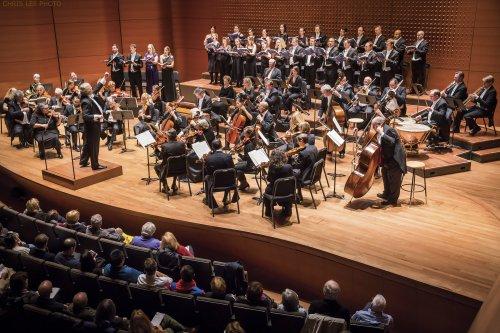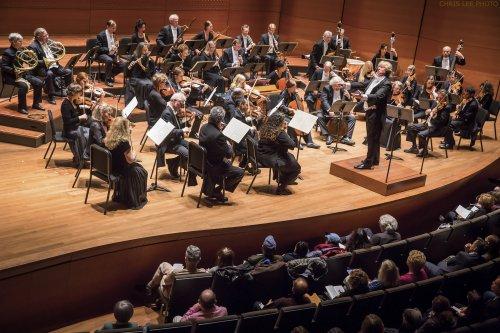American Classical Orchestra and Chorus: Cherubini, Beethoven and Mozart
A wonderful evening: two major masterpieces performed with elegance, energy and creative warmth.

American Classical Orchestra led by artistic director Thomas Crawford (Photo credit: Chris Lee)
[avatar user=”Jean Ballard Terepka” size=”96″ align=”left” ] Jean Ballard Terepka, Music Critic[/avatar]Directing instrumentalists and singers with detailed attention to both the needs and the strengths of each, ACO founder and director Thomas Crawford elicits from them all deeply felt and generously offered performances. Recently, at Alice Tully Hall, Cherubini, Beethoven and Mozart were all well served by the American Classical Orchestra and Chorus.
American Classical Orchestra has a distinctive sound: superbly skilled musicians playing period instruments produce simultaneous brightness and warmth, intimacy and grandeur. American Classical Chorus consists of singers whose musicianship is disciplined and elegant: within the organic integrity of the chorus as a whole, individual singers are alert to both their own sections and the relationships among all the sections.
Before the performance, Crawford gave one of his well-known – and deservedly well-liked – talks; he was joined on stage by the whole orchestra and chorus for demonstrations of Crawford’s musical observations and discussion-points. Crawford’s talks reflect his many interconnected musical interests: he successfully weaves together music history, critical and theoretical analyses and anecdotes (from both composers’ lives and Crawford’s own). Conveying his own sensitivity to composers’ creative processes, Crawford systematically encourages listeners to be alert to composers’ assumptions and surprises, inheritances and innovations.
The concert opened with the Overture to Cherubini’s rarely performed 1788 opera Démophoon. The eight-minute piece begins in ominous moodiness, promises a juicy narrative (as all good opera overtures do), and ends in happy optimism. It’s certainly not a major piece of music – in either its demands nor its significance – but it’s a lovely and interesting offering, a good way to set up the two exceptionally well-known Beethoven and Mozart pieces that followed: lively and attractive competence lives at a far distance from genius.

Bass Steven Eddy, tenor Brian Giebler, soprano Clara Rottsolk, soprano Hélène Brunet and American Classical Orchestra Chorus (Photo credit: Chris Lee)
This performance of Beethoven’s Eighth Symphony represented both ACO and Crawford at their best. The orchestra played with clarity and generous invitation. Drama was never muddy or driven. Beethoven’s surprises – delicacy, lightness; a minuet of sweet elegance; sturdy optimism and sweeping affirmation – were fresh and clean. One of Crawford’s most important gifts was consistently realized: Crawford conducts so as to enable audiences to hear composers’ creative thinking unfold.
From its very opening, the Mozart Mass in C minor proved to be a superior performance. The consistently fine balances between orchestra and chorus were testament to both the musicians’ inherent trust in Crawford as their director and his in them. The singers’ sound was, according to the needs of the liturgical and sacred texts, warm and inclusive, evocative and powerful.
The two soprano soloists were marvelous. Hélène Brunet combines supple lyricism with technical elegance. Clara Rottsolk’s voice is at once silvery and earthy, delicate and powerful. In their individual arias, both women committed to highly ornamented interpretations; both were able to make ornament feel like a spontaneous, unplanned and experimental development of ideas. In his conducting, Crawford gives his best singers – such as Brunet and Rottsolk – considerable room to make the music their own without ever losing coherence or the appropriate tempo. When singing together, as in “Domine Deus, Rex caelestis,” these sopranos’ voices were beautifully matched.
The tenor Brian Giebler and baritone Steven Eddy – both, clearly, fine musicians – simply didn’t have as much to do as the sopranos: Mozart just didn’t write as much for them in this mass as he did for the women. Perhaps because they sang so little, Giebler and Eddy didn’t quite get their footing in their individual arias: neither man’s voice fully commanded the space, though when their voices were heard in their individual arias, the musical quality of their singing was pleasing and effective. It was a happy surprise, therefore, that in the final soloists’ quartet at the end of the piece, “Benedictus qui venit,” all four singers’ voices were equally audible and eloquent.

American Classical Orchestra led by artistic director Thomas Crawford (Photo credit: Chris Lee)
Individual movements of the mass were especially wonderful. The “Gratias agimus tibi” was magisterial. The “Qui tollis” movement was gorgeous. Its opening brought sadness and magnificence together into a single essence; the sudden pianissimo drop for “Suscipe deprecationem nostrum” was movingly poignant; the final “Miserere” was richly beautiful.
The mass’ conclusion – Crawford elected the 2005 Robert Levin adaptation of the unfinished piece – was marvelous: with the whole chorus and all four soloists singing “Dona nobis pacem,” exuberance and joy prevailed: this mass triumphantly affirmed that God will indeed grant us peace.
Crawford’s passion for both the orchestra he founded and the late seventeenth, eighteenth and early nineteenth centuries’ music he champions is happily evident in all aspects of his musicianship and his performance style. So immersed in the music he loves that he often conducts without a score, Crawford is both boyish in his glee and formidable in the seriousness of his endeavors.
In a city already thick with important musical leaders, New Yorkers are lucky to have Crawford – with his thoughtfully developed and determined sense of musical mission – in their midst.
American Classical Orchestra and Chorus: Cherubini, Beethoven and Mozart (November 7, 2017)
Alice Tully Hall at Lincoln Center
1941 Broadway at 65th Street, in Manhattan
For more information: visit http://www.aconyc.org
Running time: two hours and 15 minutes including one intermission






Leave a comment